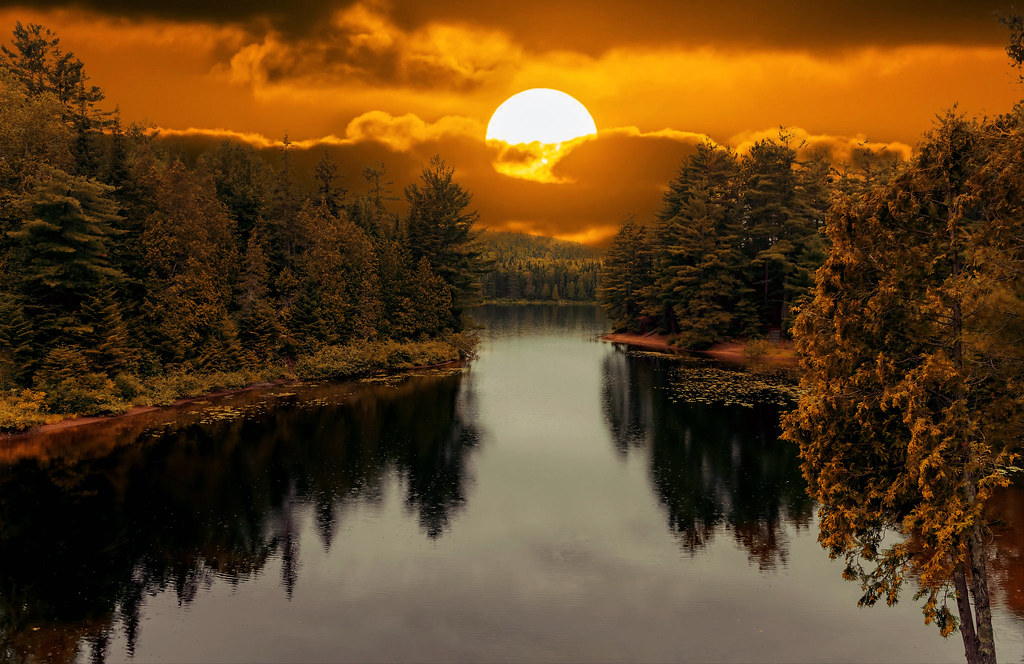La Mauricie National Park is a natural paradise located in Quebec, Canada, known for its beautiful forests, rushing rivers, and stunning waterfalls. The park is home to a wide variety of wildlife, including black bears, moose, deer, and beavers, as well as a variety of birds, such as bald eagles, ospreys, and hummingbirds. Visitors can enjoy a variety of outdoor activities, including hiking, fishing, camping, and kayaking.

The park can be reached by car via Highway 155 or by flying to the nearby airport in Trois-Rivières, which offers flights from Montreal and Toronto. The best time to visit the park is during the summer months, but it’s also beautiful in the fall and winter.
Visitors can choose from various accommodation options, including camping in one of the park’s campgrounds, staying in a cabin or lodge, or staying in a hotel just outside the park. There are also plenty of options for dining in the park, with restaurants like Boulangerie-Pâtisserie du Vieux Moulin and Au P’tit Gîte and casual options like La Cabane à Poutine and Auberge du Parc national de la Mauricie. Overall, La Mauricie National Park offers visitors an opportunity to explore the natural beauty of Quebec and enjoy a variety of outdoor activities.
Did you know about La Mauricie National Park?

- La Mauricie National Park is located in the Mauricie region of Quebec, Canada, and covers an area of 536 square km / 207 square mi.
- The park contains 150 lakes and many ponds and is home to various wildlife, including moose, black bears, beavers, and otters.
- The park is popular for outdoor activities such as camping, canoeing, and kayaking and is named after the nearby Saint-Maurice River.
- The name “Mauricie” was first used in 1933 by Bishop Albert Tessier to refer to an administrative region of the Government of Quebec.
- The Mauricie region is characterized by the Saint-Maurice River, which is also known by other names in different languages, such as Tapiskwan Sipi in Attikamekw, Oquintondili in Wyandot and Madôbalodenitekw in Abenaki.
- The region covers other watersheds, including the Champlain River and half the territory of the Batiscanie, Quebec, and is named in honor of the Lordship of Maurice Poulin La Fontaine.
- The Mauricie National Park is located in Quebec, Canada, about 15 km north of Shawinigan and 45 km north of Trois-Rivières.
- The park is accessible from the villages of Saint-Jean-des-Piles and Saint-Mathieu-du-Parc and is bordered by the Mastigouche Wildlife Reserve, Zec du Chapeau-de-Paille, and the Saint-Maurice Wildlife Reserve.
- The park is part of the Grenville Province. It is located on a plateau of older metamorphic rocks, with valleys and faults created by the retreat of glaciers during the Wisconsin glaciation.
- The Mauricie National Park contains over 440 species of vascular plants, 68 species of lichens, and more than 85 species of mosses.
- Forest covers 93% of the park’s territory and is located at the northern treeline of Quebec. It includes 30 different species of trees.
- The park is home to an endangered species, the butternut tree (Juglans cinerea).
- The park is a habitat for a variety of bird species, including the ovenbird, black-throated blue warbler, veery, red-eyed vireo, the eastern wood pewee, and sapsucker.
- The park is also home to eight species at risk, including the whip-poor-will, nighthawk, chimney swift, olive-sided flycatcher, Canada warbler, peregrine falcon, and rusty blackbird.
- The park has a limited variety of reptiles and amphibians, with only five species of reptiles and 14 species of amphibians.
- Mammals that inhabit the park include the snowshoe hare, raccoon, moose, beaver, porcupine, groundhog, river otter, marten, red fox, black bear, coyote, lynx, mink, fisher, and eastern wolf.
- The park’s lakes have relatively poor fish fauna due to the country’s youth, but the brook trout is the most commonly found species, and the lakes also contain populations of stickleback and spoonhead sculpin.
Google Maps La Mauricie National Park
This embeddable Google Map generated for free on Canada Maps.com